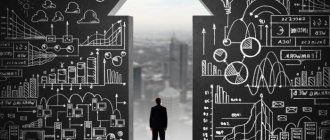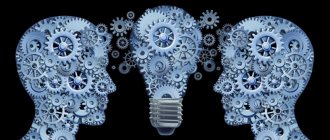Human Origins
The main provisions of the theory of human evolution are formulated in the works of Charles Darwin . These were bold views for that time, since religious views on the origin of humans, animals, and life in general on Earth dominated. The founder of biological systematics, C. Linnaeus, even before Charles Darwin, made assumptions about the relationship between humans and great apes ( Fig. 1 ).
Rice. 1. Model of the evolutionary process according to Linnaeus and Darwin
Modern anthropology is a young science. "Anthropos" means "man". Anthropologists study the origins and formation of humans as a biological species, populations, the reasons for their diversity, and interactions.
According to the laws and rules of taxonomy, modern people belong to the genus Human, the species Homo sapiens, the subspecies H. sapiens sapiens,
In the 20th century, the species Homo habilis was considered the first “real” human. This is a skilled man, whose remains were found in Tanzania’s Olduvai Gorge in 1960 ( Fig. 2 ). Primitive man already used tools.
Rice. 2. Paleontological excavations
The next stage of evolution is Pithecanthropus. The systematic name of this ancestor is Homo erectus, which translates to “Homo erectus.” This ancestor was engaged in hunting, gathering, and fishing. Gradually, the settlement and isolation of Homo erectus groups occurred. Thus, Neanderthals appeared in Europe about 40 thousand years ago. These were the direct ancestors of modern people.
The theory of the origin and development of man existed almost unchanged from the time of Darwin until the end of the 20th century. Then, in the Middle East, fossil remains of modern humans were found, the age of which was 90 thousand years. Similar discoveries have been made in other regions. This means that modern man was formed over the last 100–200 thousand. The discoveries caused the “evolution” of the theory, the emergence of different models of the origin of man.
Man as a species, his place in the system of the organic world
Many features of the body structure, functions of organs and systems confirm the commonality of humans and animals. Thus, during the development of the embryo, a notochord appears, gill slits are formed in the pharynx, and a neural tube develops, as in other groups of chordates. A spine and two pairs of limbs appear, like in vertebrates. At subsequent stages of development, the fetus acquires human features.
Man in the system of the organic world:
- Animal Kingdom.
- Subkingdom Multicellular.
- Phylum Chordata.
- Subtype Vertebrates (Cranial).
- Class Mammals.
- Primate Squad.
- Section Narrow-nosed monkeys.
- Family Hominidae.
- Rod Man.
- Species Homo sapiens.
- Subspecies H. sapiens sapiens.
Feeding babies with milk, which is formed in the mammary glands of women, confirms the relationship between humans and mammals. Other similar features: warm-blooded, four-chambered heart, seven cervical vertebrae, presence of body hair. The intrauterine development of the embryo occurs in the same way as in placental animals. The embryo is connected to the mother through the placenta.
Manifestations of similarities between humans and animals :
- Similar structure of skeletal sections and organ systems.
- Chromosome set in cells.
- Similarity of embryos.
- Blood composition.
- Horny plates on fingers.
- Common diseases and parasites.
- Rudiments - third eyelid, appendix, coccyx.
- Atavisms - hairiness, multiple nipples, tail rudiment.
Many features indicate that the species H. sapiens belongs to the family of great apes. Humans are distinguished from the most highly organized modern primates by their increased brain volume and articulate speech. The karyotype has 46 chromosomes, not 48, like in monkeys.
The differences between humans and animals are the result of biological evolution:
- Double arched foot.
- Locomotion on two limbs.
- Vertical position of the torso and head.
- Adaptation of the upper limbs for grasping, freeing the hands for work.
- Large volume of the forebrain, significant development of the cerebral cortex.
- Complication and great variety of higher nervous activity.
- Ability to make tools.
The species characteristics of Homo sapiens are considered to be the use of the upper limbs for labor, making tools, and the ability to think abstractly. People carry out collective activities that are more subject to social rather than biological laws (like social animals).
Life cycle
The biological species leads a special way of life, different from other representatives of the class Mammals.
Breath
The organs of the respiratory system play an important role in gas exchange. The process begins in the nasal cavity, the air masses warm up, enter the trachea and bronchi, and then into the lungs. From there, oxygen molecules are transported through the bloodstream to all organs and tissues.
The reverse flow of blood carries carbon dioxide molecules that are expelled. Red blood cells, or erythrocytes, carry oxygen in the body. With their deficiency, oxygen starvation of organs occurs.
Nutrition
Representatives of the genus Humans are omnivorous mammals. They eat plant and animal foods. The second one must be thermally treated before use.
Teeth and tongue are important parts of the digestion process. The first helps to grind the products, the second helps to push them into the esophagus. After entering the stomach, active production of hydrochloric acid begins, bile comes from the gallbladder, and the pancreas produces enzymes for digesting food. Afterwards, food enters the small intestine, then into the large intestine.
After final processing and absorption of nutrients, the products are excreted in the feces. The normal functioning of the digestive system largely depends on the composition of the diet and the predominance of certain products in it. People eat many mammals, mollusks, and birds.
Reproduction
Individuals from the family Hominidae are dioecious and are characterized by viviparity. Puberty occurs at the age of 15-18 years. The ability to conceive depends on a woman's menstrual cycle, which lasts on average 28 days. During pregnancy, a woman is sexually active, which is not typical for other mammals.
Reproductive function in women lasts up to 40-50 years, after which menopause occurs. Men are usually able to conceive even in old age.
Fertilization is internal, the growth of the fetus occurs in the woman's uterus. After 40 weeks of intrauterine development, a fully formed baby is born. For several months, he feeds on mother's milk, which ensures the supply of necessary substances and strong immunity. The birth of more than 1 baby occurs approximately once in 80-90 births.
No baby mammal requires as much attention and care as a human baby. Both parents usually take part in raising the child.
Lifespan
The average life expectancy of individuals in developed countries exceeds 70 years. In others, this figure is 65-69 years.
In most cases, the indicator depends on dietary habits, professional activities and hereditary predisposition.
Hypotheses of the origin of modern humans
Leakey archaeologists were the first to suggest that the ancestors of modern humans lived in Africa. The hypothesis is based on the sensational discoveries of human sites in Tanzania and Ethiopia (Olduvai Gorge). This is how views on a single center of human origin emerged. For many years Africa was considered the only ancestral home of man.
The straightforward approach to evolution, which had prevailed since the time of Darwin and Leakey's discovery, was replaced by a “tree-like” approach ( Scheme 1 ). Followers of monocentrism and polycentrism do not question the origin of humans from common ancestors with modern apes.
Scheme 1. Illustration of the hypotheses of polycentrism and monocentrism
According to the hypothesis of polycentrism or multiregional origin, the first people appeared in Africa and began to settle in other territories relatively early ( Scheme 1 ). In new habitats, evolutionary changes occurred that were independent of events in other centers. The multiregional hypothesis has received much paleoanthropological and archaeological evidence.
Proponents of this scientific view of hominid origins point to the parallel evolution of humans in Africa, Europe, and Asia. Polycentrists explain the specific structural features of representatives of different territorial groups by their origin from different species of paleoanthropes or archanthropes. Also, researchers pay attention to the uniformity and parallelism of cultural development among different groups in the territory of the Old World.
The monocentrism hypothesis is the doctrine of one center of human origin. Africa is recognized as the homeland of the most ancient people on the planet. All subsequent waves of migrations and settlement of other parts of the world also began on the hot continent.
Man, according to the monocentrism hypothesis, first appeared in Africa. It was on this continent that the remains of the female “Lucy”, who lived 3.18 million years ago ( Fig. 3 ), and the oldest stone tools 3 million years old were found.
Rice. 3. The oldest human ancestor is “Lucy”
Subsequently, the first people settled across the territory of Eurasia, mixing with the aborigines already living there. Archaeological and anthropological data confirm the monocentrism hypothesis.
More than 2 million years ago, ancient people migrated from the “African cradle” of humanity to Europe and Asia. These were representatives of the species Homo habilis. Gradually, they moved further and further across the territory of Eurasia, perhaps following herds of animals - objects of hunting.
The hypothesis of the extratropical origin of man describes the emergence of the first people in the high latitudes of Eurasia (Siberia). This doctrine is supported by the discovery of Paleolithic sites on the territory of modern Yakutia.
The hypothesis of the divine origin of man, which relates not to biology, but to theology, has not lost its significance. There are assumptions about the penetration of the first people from other planets, the crossing of wild ancestors with intelligent creatures from outer space.
Historical past of people
The first people on Earth. The name of the ape-man - Pithecanthropus - was given to one of the earliest finds, made in the 19th century in Java. For a long time, this find was considered a transitional link from ape to man, the first representatives of the hominid family. These views were facilitated by morphological features: a combination of modern-looking bones of the lower limb with a primitive skull and intermediate brain mass. However, Pithecanthropus of Java is a rather late group of hominids. From the 20s of the twentieth century to the present, an important discovery was made in southern and eastern Africa: the remains of bipedal Plio-Pleistocene primates (from 6 to 1 million years old) were found. They marked the beginning of a new stage in the development of paleontology - the reconstruction of these stages of hominid evolution based on direct paleontological data, and not on the basis of various indirect comparative anatomical and embryological data.
The era of the bipedal apes Australopithecus. The first australopithecus of East Africa, Zinjanthropus, was discovered by the spouses L. and M. Leakey. The most striking characteristic of australopithecines is their upright posture. This is evidenced by the structure of the pelvis. Upright walking is one of the oldest human acquisitions.
The first representatives of the human race in East Africa. Together with the massive australopithecines, other creatures lived in East Africa 2 million years ago. This first became known when, the next year after the discovery of Zinjanthropus, the remains of a miniature hominid were discovered, the brain volume of which was no less (and even more) than that of Australopithecus. It was later revealed that he was a contemporary of Zinjanthropus. The most important discoveries were made in the lowest layer, dating back to 2–1.7 million years. Its maximum thickness is 40 meters. The climate when this layer was laid was more humid and its inhabitants were zinjanthropus and prezinjanthropus. The latter did not last long. In addition, stones with traces of artificial processing were also found in this layer. Most often it was pebbles ranging in size from a walnut to 7–10 cm, with a few chips of the working edge. Initially it was assumed that the Zinjanthropes were able to do this, but after new discoveries it became obvious: either the tools were made by a more advanced Zinjanthropus, or both inhabitants were capable of such initial stone processing. The emergence of the fully opposable thumb grip must have been preceded by a period of predominant power grip, when the object was grabbed by the handful and clamped in the hand. Moreover, it was the nail phalanx of the thumb that experienced particularly strong pressure.
Prerequisites for anthropogenesis. The common ancestors of apes and humans were gregarious, narrow-nosed monkeys that lived in trees in tropical forests. The transition of this group to a terrestrial lifestyle, caused by climate cooling and the displacement of forests by steppes, led to upright walking. The straightened position of the body and the transfer of the center of gravity caused the replacement of the arched spinal column with an S-shaped one, which gave it flexibility. An arched springy foot was formed, the pelvis expanded, the chest became wider and shorter, the jaw apparatus was lighter, and most importantly, the forelimbs were freed from the need to support the body, their movements became more free and varied, and their functions became more complex. The transition from using objects to making tools is the boundary between ape and man. The evolution of the hand followed the path of natural selection of mutations useful for work activity. Along with upright walking, the most important prerequisite for anthropogenesis was the herd lifestyle, which, with the development of work activity and the exchange of signals, led to the development of articulate speech. Concrete ideas about surrounding objects and phenomena were generalized into abstract concepts, and mental and speech abilities developed. Higher nervous activity was formed, and articulate speech developed.
Stages of human development. There are three stages in human evolution: ancient people, ancient people and modern (new) people. Many populations of Homo sapiens did not replace each other sequentially, but lived simultaneously, fighting for existence and destroying the weaker.
| Human Ancestors | Progressive features in appearance | Lifestyle | Tools |
| Parapithecus (discovered in Egypt in 1911) | We walked on two legs. Low forehead, brow ridges, hairline | Considered to be the oldest ape | Tools in the form of a baton; hewn stones |
| Dryopithecus (bone remains found in Western Europe, South Asia and East Africa. Antiquity from 12 to 40 million years) | According to most scientists, Dryopithecus is considered a common ancestral group for modern apes and humans. | ||
| Australopithecus (bone remains dating back 2.6-3.5 million years were found in Southern and Eastern Africa) | They had a small body (length 120–130 cm), weight 30–40 kg, brain volume 500–600 cm2, and walked on two legs. | They consumed plant and meat foods and lived in open areas (such as savannas). Australopithecines are also considered as a stage of human evolution that immediately preceded the emergence of the most ancient people (archanthropes). | Sticks, stones, and animal bones were used as tools. |
| Pithecanthropus (the oldest man, remains discovered - Africa, Mediterranean, Java; 1 million years ago) | Height 150 cm; brain volume 900–1,000 cm2, low forehead, with brow ridge; jaws without chin protrusion | Social lifestyle; They lived in caves and used fire. | Primitive stone tools, sticks |
| Sinanthropus (China and others, 400 thousand years ago) | Height 150–160 cm; brain volume 850–1,220 cm3, low forehead, with brow ridge, no mental protuberance | They lived in herds, built primitive dwellings, used fire, dressed in skins | Tools made of stone and bones |
| Neanderthal (ancient man); Europe, Africa, Asia; about 150 thousand years ago | Height 155–165 cm; brain volume 1,400 cm3; few convolutions; forehead low, with brow ridge; the chin protuberance is poorly developed | The social way of life, the construction of hearths and dwellings, the use of fire for cooking, dressed in skins. They used gestures and primitive speech to communicate. A division of labor appeared. First burials. | Tools made of wood and stone (knife, scraper, multifaceted points, etc.) |
| Cro-Magnon - the first modern man (everywhere; 50–60 thousand years ago) | Height up to 180 cm; brain volume - 1,600 cm2; high forehead; the convolutions are developed; lower jaw with mental protuberance | Tribal community. They belonged to the species Homo sapiens. Construction of settlements. The emergence of rituals. The emergence of art, pottery, agriculture. Developed. Developed speech. Domestication of animals, cultivation of plants. They had rock paintings. | Various tools made of bone, stone, wood |
Modern people. The emergence of people of the modern physical type occurred relatively recently (about 50 thousand years ago), who were called Cro-Magnons. Increased brain volume (1,600 cm3), well-developed articulate speech; the construction of dwellings, the first rudiments of art (rock painting), clothing, jewelry, bone and stone tools, the first domesticated animals - everything indicates that real man finally separated from his animal-like ancestors. Neanderthals, Cro-Magnons and modern humans form one species - Homo sapiens. Many years passed before people moved from an appropriating economy (hunting, gathering) to a producing economy. They learned to grow plants and tame some animals. In the evolution of Cro-Magnons, social factors were of great importance; the role of education and the transfer of experience grew immeasurably.
Driving forces and stages of human evolution
Anthropogenesis occurs under the influence of two groups of factors - biological and social. Therefore, a person is called a biosocial being. The driving forces of anthropogenesis contributed to the development of a species that took a dominant position in the animal world. The biological factors of evolution were substantiated by Charles Darwin ( Fig. 4. ) in his work “The Origin of Man and Sexual Selection (1871).
Rice. 4. Charles Darwin
Biological factors of human evolution:
- Hereditary variability.
- Struggle for existence.
- Individual natural selection, which is associated with the appearance of upright walking, changes in the hand, and brain development.
- Group selection, which caused the emergence of social organization (acted at the level of the family, tribes).
The appearance of morphophysiological characteristics different from animals naturally follows from the factors listed above.
Changes that have occurred in the human body:
- separation of functions of the upper and lower extremities;
- S-shaped curve of the spine;
- upright walking;
- arched foot;
- change in the ratio of the facial and cerebral parts of the skull.
The effect of social factors on anthropogenesis is shown by F. Engels in the article “The Role of Labor in the Process of Transformation of Ape into Man (1896). The coordinated action of the driving forces of anthropogenesis led to the formation of a biosocial being.
Structure
In the external and internal structure of the representatives of the genus, characteristic features can be identified that allow them to be classified in the kingdom Animalia, the class Mammals.
External
The appearance of individuals differs from other representatives of the class.
Characteristic appearance features:
- The head is large, well mobile due to the muscles of the neck. Eyes vary in size, which depends on race. Supraorbital ridges are absent.
- The nose of individuals has different shapes, sizes and lengths. The mouth is framed by lips, the thickness of which varies.
- The auricles of representatives of the Chordata type are rounded and do not have hair.
- The head is covered with hair that frames the face. The number, density, thickness, color and strength of hairs differ among different representatives.
- The upper and lower limbs are five-fingered, with a nail plate at the tips. The arms are long, reaching the middle of the thighs. Legs can be long or short. The fingers on the upper extremities are longer, and those on the lower extremities are shorter.
- The average height of a man is 175 cm, a woman - 165 cm. Weight differs depending on eating habits and individual characteristics.
- The skin is soft, elastic, covered with hairs in some areas. In adults, hair growth is observed in the genital area, armpits, arms and legs, especially in men. The latter also have large amounts of hair on their face.
- Sexual dimorphism is pronounced. Women have a wide pelvis, narrow shoulders, men have wide shoulders and a narrow pelvis. The external genitalia are represented in men by the penis and testicles, in women by folds of skin called the labia and mammary glands.
Within the species, several groups (races) are distinguished, representatives of each differ in appearance. Some traits are characteristic only of individuals of a certain race.
Internal
The internal structure of representatives of the Hominid family is somewhat different from individuals of the class. Organs and tissues have structural features and unusual locations.
Main features of the internal structure:
- The oral cavity contains the tongue, teeth, the larynx contains the vocal cords and tonsils.
- The throat smoothly passes into the trachea and esophagus, located parallel to each other. The trachea is wide, long, and passes into the bronchi. The esophagus is made up of an inner mucous layer and muscles that help it contract to move food along.
- Below the larynx in front of the trachea is the thyroid gland, which performs important functions.
- The bronchi have a complex structure and pass into the lungs. The right lung is slightly larger than the left.
- The heart is four-chambered, has two atria and two ventricles, separated by septa. The muscular organ is located in the heart sac or pericardium. Venous and arterial blood in the chambers do not mix due to the presence of valves that prevent regurgitation.
- The circulatory system is developed, consisting of large veins, arteries and small capillaries. People have two circles of blood circulation: large and small. The first allows blood to move throughout the body, delivering oxygen and nutrients to tissues and organs. The second is called pulmonary, it plays an important role in gas exchange.
- The digestive system consists of the oral cavity, esophagus, stomach, small and large intestines, duodenum, liver, pancreas, gall bladder, and rectum.
- The excretory organs are represented by the kidneys, from which the ureters emerge and go into the bladder. Processed food exits through the anus, which ends at the rectum. At the top of each kidney there are paired glands - adrenal glands, which produce hormones important for the body.
- The male internal genital organs are represented by the testes and prostate gland. A woman has a uterus, ovaries, fallopian tubes, and vagina.
- The skull is large and consists of paired bones that are immovably connected to each other. The upper and lower jaws are movably attached to the skull.
- The spine of representatives of the Hominid family consists of 33-34 vertebrae, divided into 5 sections: cervical, thoracic, lumbar, sacral, coccygeal. Between the vertebrae there are discs made of cartilage tissue.
- The organs of the chest are protected by the sternum and ribs. The bones of the limbs are connected by a joint capsule, which contains fluid to lubricate the cartilage and normal functioning of the joint.
- The nervous system is very developed. The brain is large and occupies the entire internal area of the cranium. It consists of several sections: middle, oblongata, pineal gland, cerebellum, pituitary gland, cerebral hemispheres. The brain contains gray and white matter, has a cortex, and has a large number of convolutions on top.
- In the area where the skull connects with the cervical spine, the brain becomes the spinal cord. It has sensory and motor roots, is located inside the spinal canal and is well protected from damage by the vertebrae.
The spinal column and limb bones make up the skeleton of an individual. Upright walking is possible precisely due to the peculiarities of its structure. The sense organs are represented by paired eyes, ears, sinuses, and tongue. The sense of touch is achieved through the sensitive skin.
Main stages of anthropogenesis
Man did not descend from currently existing apes. About 25 million years ago, the common ancestor of these two groups of primates, Dryopithecus, lived. He climbed trees, moved on all four limbs and only on the lower two. He carried food and weapons of defense in his hands. Approximately 5–8 million years ago, the ancestors of great apes and humans separated.
Rice. 5. Australopithecus skulls
Australopithecus evolved from Dryopithecus 4 million years ago ( Fig. 5 ). The ancestors who lived in the savannas of Africa gave rise to other branches that could early leave the territory of the hot continent and develop for a long time in parallel on other continents and archipelagos.
More than 2 million years ago, representatives of the genus Homo, the species Homo habilis, separated. This creature is short (1.5 m), with a brain volume of 670 cm3. A skilled person used crude tools made from chopped or hewn pebbles. There were the rudiments of facial expressions and speech.
The earliest people
H. erectus evolved from H. habilis. This biological species formed in Africa 1.6 million - 400 thousand years ago and settled over vast territories in Asia and Europe. Fossil remains of Pithecanthropus were discovered on the island. Java. The remains of Sinanthropus have been found in China.
Heidelberg man lived in Europe at the same time. These representatives were united into a group of ancient people (archanthropes). Archanthropes had the features of a monkey and a human, lived in a primitive herd, and used fire.
The problem of overpopulation of the earth
The problem of overpopulation today is acute in some countries of the world (Japan, China). In other regions the situation is more stable. Scientists give pessimistic and optimistic forecasts.
Pessimists argue that with the rapid growth of the population, natural resources will not be enough to ensure hygienic living standards. Optimists are confident that with a competent approach and saving resources, it is possible to stabilize the situation and avoid a crisis.
First modern humans
Appeared 90–40 thousand years ago. Cro-Magnons had a height of up to 180 cm, a high straight forehead, and a developed chin protuberance. The brain volume reached 1600 cm3. The Cro-Magnons lived in tribal communities, sewed clothes from skins, built homes, tamed animals, cultivated the land, and painted on the walls of caves ( Fig. 7 ).
Rice. 7. Rock painting
More developed speech, the manufacture of tools, the emergence of religion and culture are the distinctive features of modern people.
Human races, their genetic relatedness
In the process of biological evolution, the most stable groups of people have emerged within the same species and subspecies of H. sapiens sapiens. These are races that are characterized by certain genotypes and phenotypes. Representatives of the same race are characterized by common hereditary characteristics - skin color, eye shape, eyelid structure, hair structure and color ( Table 1 ).
Table 1.
Modern races of people
| Asian-American (Mongoloid) | Eurasian (Caucasoid) | Equatorial (Australian-Negroid) |
| Signs | ||
|
|
|
The reason for the formation of races in the distant past was settlement across continents. Subsequent geographic isolation consolidated adaptive traits. Morphophysiological differences acquired during the process of biological evolution are not evidence of different degrees of organization. All races and peoples are at the same stage of evolution. Crossbreeding produces fertile offspring. Claims of racial superiority have no scientific explanation.
Nationalities and nations should be distinguished from races. Ethnic groups were formed as a result of social processes.
Classification of personality psychotypes depending on character
People differ not only in their character traits, but also in their attitude to life, society and moral values. Although there is a concept of proper behavior, people behave differently.
The German psychoanalyst and sociologist E. Fromm introduced the concept of “social character” and defined it as a certain identical set of character traits in the personality structure of the majority of members of a particular community. Any community, class or group of people has a certain social character.
Social character was taken as the basis for the classification of psychological personality types.
Psychological personality types according to E. Fromm:
- "Masochist-sadist"
A person who is inclined to direct aggression towards himself or other people if he considers them to be guilty of ongoing personal failures or problems of the whole society. Such people strive for self-improvement, are insecure, punctual, responsible, demanding, domineering, and love to terrorize others, justifying their actions with good intentions.
Psychological masochism is almost always combined with sadism. However, there are people who are more inclined to one of the types.
Individual typological features of a “masochist”: self-deprecation, self-criticism, tendency to always blame oneself for everything. Fromm defined a “sadist” as an authoritarian personality. This is an exploitative man, domineering and cruel.
- "Destroyer"
He does not cause suffering to himself or others, but aggressively eliminates the cause of his troubles. In order not to feel powerless and frustrated, a person ends the relationship or interrupts the business he has started, that is, he uses destructiveness as a means of resolving any trouble. “Destroyers” are usually anxious, desperate, cowardly people, limited in the realization of their capabilities and abilities.
- "Conformist Automaton"
Unlike the two previous psychological types, the “conformist” is passive. He does not fight, but resigns himself to difficult life circumstances. This is a too labile person who has practically lost his
- "I"
He is an adaptable person who will change his point of view, behavior, principles and even type of thinking if the situation demands it. Such people are immoral, and therefore do not see anything shameful in changing points of view and life values.
This social typology does not characterize people from the best side, but it reveals the problems of society and remains extremely relevant in our time.
It is impossible to say which typology is better; they complement each other. Any personality typology allows an individual to know himself and at the same time realize his uniqueness.
Biosocial nature of man
Darwin collected convincing evidence of the common origin of primates. The studies concerned only morphophysiological changes that arose under the influence of natural selection. Social aspects of the theory of human origin were developed by F. Engels .
The effect of social factors on anthropogenesis is listed in the article “The Role of Labor in the Process of Transformation of Ape into Man (1896):
- Labor activity, the use and then the creation of tools.
- Improving brain activity.
- Hand development.
- The formation of a social way of life.
- Development of articulate speech, thinking and consciousness.
- Raising and training offspring, passing on accumulated experience to them.
The coordinated action of the driving forces of anthropogenesis ultimately led to the formation of man as a biosocial being. This is a biological species with all the ensuing features of body structure, physiology, and behavior. At the same time, man is a social being, characterized by a social way of life and speech.
The biosocial nature of man determines the relatively uniform importance of biological and social adaptation in society and the preservation of all functions. The importance of the social factor increases, while the biological factor gradually decreases. Natural selection no longer plays the role that is typical for it in populations of plants and animals.











